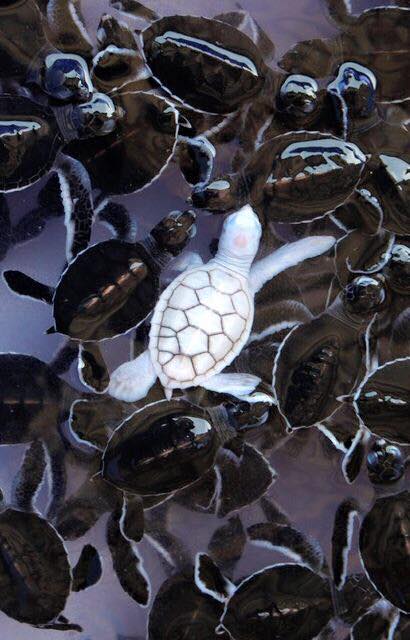We’ve discussed the mechanisms by which species arise, given enough time and environmental circumstances. These mechanisms account for the means by which evolution occurs–in other words: natural selection. Would nature select for or against the albino turtle? How would this selection take place? What can be said about the trait that results in albinism?
Tag Archives: AP Bio
The Olinguito: A New Species of Mammal is Unveiled.
This racoon-like mammal–the first carnivore to be discovered in the last 35 years–was discovered not in the wild, but thanks to a collection of South American racoon specimens that is available at the Smithsonian.

“D.C., Kristofer Helgen, curator of mammals at the Smithsonian National Museum of Natural History, presented anatomical and DNA evidence that establish the olinguito (pronounced oh-lin-GHEE-toe) as a living species distinct from other known olingos.”
“Though Helgen has uncovered dozens of unknown mammal species during previous expeditions, in this case, he did not set out to find a new species. Rather, he sought to fully describe the known olingos. But when he began his study in 2003, examining preserved museum specimens, he realized how little scientists knew about olingo diversity. “At the Chicago Field Museum, I pulled out a drawer, and there were these stunning, reddish-brown long-furred skins,” he said. “They stopped me in my tracks—they weren’t like any olingo that had been seen or described anywhere.” The known species of olingo have short, gray fur. Analyzing the teeth and general anatomy of the associated skulls further hinted that the samples might represent a new species. Helgen continued his project with a new goal: Meticulously cataloguing and examining the world’s olingo specimens to determine whether samples from a different species might be hidden among them.”–Via The Smithsonian.com.
This Protein Could Change Biotech Forever – Forbes

“Gel electrophoresis: 6 “DNA-tracks”. In the first row (left), DNA with known fragment sizes was used as a reference. Different bands indicate different fragment sizes (the smaller, the faster it travels, the lower it is in the image); different intensities indicate different concentrations (the brighter, the more DNA).” Via Wikipedia
New ways of manipulating genetic code–of writing, reading, copying, and editing the laguage of life–are cropping up almost on a daily basis. Our daily lives can change forever thanks to these advancements in biotechnology. It still remains to be seen if these changes are good or bad. I approach them with some reserve, with cautious optimism:
Bacteria, like human beings and almost every other living thing, keeps its genetic code in a library of DNA molecules. But to use that code, the organism copies the DNA into a related molecule called RNA. Cas9 can be paired with an RNA transcript to target a matching DNA sequence and cut it. That kills viruses, but scientists use it to cut DNA in exactly the place they want. The result is not so much like using a word processor as a biology lab version of what movie editors had to do back when they spliced together pieces of film.
This excerpt was taken from the article: This Protein Could Change Biotech Forever – Forbes.
Eugenics and Biotechnology.

Eugenics was a proposed solution to all of mankind’s troubles. Let’s hope that it does not catch on again.
We’ve begun with Biotechnology, chapter 20 of our book. The best possible approach I could think of for beginning this chapter, was through a film which we concluded watching today: Gattaca, directed by Andrew Niccol in 1997. Biotechnology and many of its sociological and technical implications are suggested here — sci-fi as an alternative way to approach contemporary scientific issues. One of the protagonists of the film is named Eugene, which literally means ‘well born’ (Eu = good, true; Gene = born). Thus, not surprisingly, eugenics comes to mind. A short Wikipedia excerpt from the eugenics article:
The way eugenics was practiced in this period (19th and 20th centuries) involved “interventions”, which is a euphemistic name for the identification and classification of individuals and their families, including the poor, mentally ill, blind, deaf, developmentally disabled, promiscuous women, homosexuals and entire racial groups — such as the Roma and Jews — as “degenerate” or “unfit”; the segregation or institutionalisation of such individuals and groups, their sterilization, euthanasia, and in the extreme case of Nazi Germany, their mass extermination.[6]
Eugenics became an academic discipline at many colleges and universities, and received funding from many sources.[7] Three International Eugenics Conferences presented a global venue for eugenicists with meetings in 1912 in London, and in 1921 and 1932 in New York. Eugenic policies were first implemented in the early 1900s in the United States.[8] Later, in the 1920s and 30s, the eugenic policy of sterilizing certain mental patients was implemented in a variety of other countries, including Belgium,[9]Brazil,[10]Canada,[11] and Sweden,[12] among others. The scientific reputation of eugenics started to decline in the 1930s, a time when Ernst Rüdin used eugenics as a justification for the racial policies of Nazi Germany, and when proponents of eugenics among scientists and thinkers prompted a backlash in the public. Nevertheless, in Sweden the eugenics program continued until 1975.[12] — Parentheses added by me.
The following links* provide a context on where we are in terms of eugenics in the 21st century:
1) One of the articles deals with technicals achievements that are worth a look at if we want to better understand the impact of Biotechnology in te next few decades: Life expectancy linked to DNA length.
2) This second article–with a somewhat misleading and poorly chosen title–is an interview that chillingly reminds us of the dystopia presented in Niccol’s film: China is engineering genius babies.
*Reading is compulsory.



You must be logged in to post a comment.